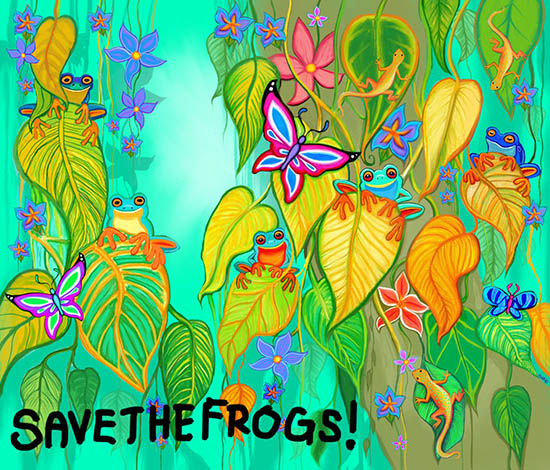Introduction
Toads and frogs have appeared in myths, folklore, proverbs, and fairytales across cultures for many centuries. These amphibians have been features in children’s stories, rituals of many cultures, and myths all around the world.

Artists have been inspired by frogs for millennia. Earth Day frog art by 2013 SAVE THE FROGS! Art Contest Grand Prize Winner Nick Gustafson.
Frogs
In medieval Europe Heket, the water goddess, often was depicted as a woman with the head of a frog. Frogs were also considered the symbol of Heqit, the midwife goddess who presided over conception and birth. As such, it was common for Egyptian women to wear metal amulets in the form of frogs to win her good favor.
Each year at the flooding of the Nile numerous frogs appeared. This event was vital to agriculture because it provided water for distant fields. Frogs represented abundance and therefore became a symbol for the number hufnu, which meant 100,000. Many native cultures place small frog coins in their purses because they believe that it prevents loss of money.
In some societies swallowing live frogs is believed to cure tuberculosis and whooping cough. According to an old British legend, carrying a dried frog in a pouch around your neck prevents epileptic seizures. Some cultures believe that a frog coming in your home might be carrying a curse, while others claim it brings good luck. Some African tribes believe that the death of a frog will cause drought, while the Maori people say that killing a frog can lead to heavy rains and floods.
Toads
Olmec tribes, known for the massive stone heads they carved from volcanic rocks, created images of a toad god of rebirth consuming its own skin. In many ancient Chinese legends the toad was viewed as a magician, master of spells, and trickster. In many shamanistic traditions of South and Central America, a hallucinogenic substance derived from toads and frogs is used to purify the body.
In medieval Europe, toads were considered evil creatures whose body parts had strange powers. Some of these views were formed by authors from Classical Rome and Greece, whose writings had immense influence on the public opinion. Shakespeare’s play As You Like It alludes to a widely held superstition, which concerned a jewel that was supposed to be found inside the head of the toad. Once placed in a ring or necklace, this jewel, known as “toad-stone”, would warm up or change color in the presence of venom, protecting the wearer from foul play. Additionally, toads took on the role of evil spirits who assisted witches in their evil designs.
In this culture toads were also considered symbols of romantic jealousy. For many cultures, such as ancient Egypt, frogs and toads represented fertility and were associated with renewal and rebirth. In pre-Colombian Mesoamerica frogs and toads were viewed as spirits of rain. These amphibians were used in many rituals that were thought to bring the rains. The Aymara tribe of Peru and Bolivia blamed toads for droughts and punished them for withholding the rain.
The early Aztecs viewed the toad as the earth mother goddess, who governed the cycle of death and rebirth. The ancient Chinese viewed the toad as a female force and the moon was seen as its symbol. As such many Chinese tales allude to the toad whose face is visible only at the full moon. This moon-toad was also thought to swallow the moon at times causing eclipses.
Unfortunately, toads and frogs have permeable skin, making them highly susceptible to environmental pollution. Will they remain in the wild, or only be remembered through myths and legends? SAVE THE FROGS! is doing everything we can to ensure that these amazing amphibians continue to live on in both the wild and as an integral part of our culture.


